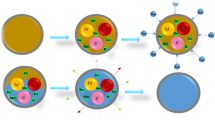Abstract
Most fertilizers have some tendency to form lumps or agglomerates (caking) during storage. The mechanism of caking in fertilizers is most often attributed to the formation of salt bridges and/or capillary adhesion. The severity of caking can be influenced by a number of factors, such as chemical composition, moisture content, particle structure, mechanical strength, hygroscopic properties, product temperature, ambient conditions, storage time, and storage pressure. The various methods of reducing or eliminating caking in fertilizers basically involve process control, storage/packaging conditions, and/or addition of anticaking agents.
Caking mechanisms, factors that influence caking, and methods of prevention are discussed in this paper. Particular attention is given to the various types of anticaking agents and their modes of action. The paper also provides a fairly comprehensive list of commercially available anticaking agents and their producers.
Similar content being viewed by others
References
Using Anticaking Agents (1983) Nitrogen 146: 21–23, November–December
Kurshinnikov IN and Chelikidi GF (1978) Methods of Eliminating the Caking of Fertilizers. Proceedings of the Soviet-Swedish Symposium on the Beneficiation of Phosphate Rock, pp 180–186, Tallinn, Estonia
Rosenblom J and Zettervall S (1978) Anticaking Treatments of Granular Inorganic Salts Such as Phosphate Based Complex Fertilizers and Ammonium Nitrate. Proceedings of the Soviet—Swedish Symposium on the Beneficiation of Phosphate Rock, pp 158–179, Tallinn, Estonia
Hoffmeister G (1979) Physical Properties of Fertilizers and Methods for Measuring Them, Y-147, Tennessee Valley Authority, Muscle Shoals, Alabama 35661, USA
International Fertilizer Development Center (1979) Fertilizer Manual, IFDC-R-1 (also available from the United Nations Industrial Development Organization, Vienna, Austria), Muscle Shoals, Alabama 35662, USA
Thompson DC (1972) Fertiliser Caking and Its Prevention, Proceedings No. 125, The Fertiliser Society, London, United Kingdom
Van Hijfte WHP (1981) The Coating of Straight Nitrogen Fertilizers. Proceedings of the 31st Annual Meeting of the Fertilizer Industry Round Table, pp 181–187, Washington DC, USA
Conditioning Ammonium Nitrate for Handling and Storage (1985) Nitrogen, 156: 28–34, July–August
Blouin GM (1986) Production of High-Strength Storage-Stable Particulate Urea, US Patent 4, 587, 358.
Nunnelly LM and Brummitt WC TVA's Experience in Producing and Marketing Urea LS, Z-222, Tennessee Valley Authority, Muscle Shoals, Alabama 35661, USA
Mackay PA and Sharples KS (1985) The Use of Special Oils and Coatings to Prevent Caking of Fertilizers. Proceedings No 239, The Fertiliser Society, London, United Kingdom
Author information
Authors and Affiliations
Rights and permissions
About this article
Cite this article
Rutland, D.W. Fertilizer caking: Mechanisms, influential factors, and methods of prevention. Fertilizer Research 30, 99–114 (1991). https://doi.org/10.1007/BF01048832
Issue Date:
DOI: https://doi.org/10.1007/BF01048832




